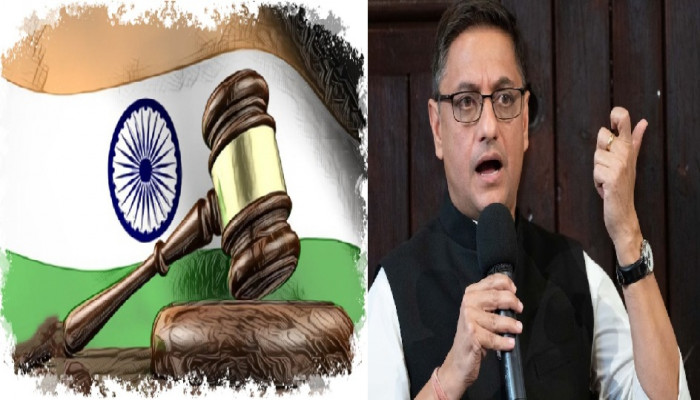Courts, Colonial Shadows and the Call for Change
- In Current Affairs
- 08:36 PM, Sep 30, 2025
- Aishwarya Hariharan
A few weeks ago, Sanjeev Sanyal, a member of the Prime Minister’s Economic Advisory Council, set off a storm with his speech at the Nyaya Nirmaan 2025 conference. His observations about the judiciary have drawn sharp reactions, particularly from the legal fraternity.
In his remarks, Sanyal stressed the urgency of reforms, pointing out that India has only two to three decades to achieve the vision of Viksit Bharat. He went on to describe the judiciary as “the single biggest hurdle” in India’s path to rapid growth, citing both structural inefficiencies and outdated practices. He also questioned the colonial hangover of addressing judges as “My Lord” or “Your Lordship” and criticised the long court vacations that stall justice for extended periods.
These comments were met with outrage. Two advocates even approached the Attorney General, seeking permission to initiate contempt proceedings against Sanyal. Several others from the legal fraternity issued strongly worded letters condemning his description of the judiciary as a barrier to national progress.
Ironically, this backlash only reinforces Sanyal’s point. The very fact that calls for contempt proceedings shows the unwillingness of certain sections in the legal fraternity to accept criticism, even when it is constructive. If questioning the judiciary is treated as a crime or contempt, then what distinguishes it from systems where rulers are above all scrutiny? In a democracy, no institution should be immune from accountability, not even the courts.
The scale of the judiciary’s challenges is undeniable. As of September 25, more than 5.34 crore cases remain pending across all courts in India, 4.7 crore in district and subordinate courts, 63.8 lakh in the high courts, and nearly 90,000 in the Supreme Court. The National Judicial Data Grid attributes delays in lower courts to at least 15 different reasons, yet for roughly three crore pending cases, no reasons are even recorded.
To those who argue that judicial delays can simply be pinned on the government, I would suggest looking at what the Supreme Court itself has recorded as the primary causes of pendency. The institution says delays often arise because counsel is unavailable, accused persons abscond, witnesses go missing, documents are not produced, or because proceedings are stayed by lower courts, district courts, or even the Supreme Court itself.
Given these realities, brushing aside the issue under the blanket of “government appointments” is nothing more than an excuse. Blaming the government may be convenient, but it does not withstand scrutiny. The real, systemic problems of case management, procedural inefficiencies, and accountability within the judiciary cannot be wished away by shifting responsibility elsewhere.
Such staggering backlogs are not new, yet meaningful reforms have been endlessly delayed. Instead of silencing voices that highlight these problems, the legal fraternity should acknowledge that judicial reform is long overdue.
If India truly aspires to become a developed nation, we cannot afford to let colonial legacies and systemic inertia dictate the pace of justice. Reforming the judiciary is not merely desirable; it is essential for growth, fairness, and democracy itself. Confronting an uncomfortable reflection is often the necessary prelude to progress.
The concerns raised by Sanjeev Sanyal cannot be reduced to the issue of judicial delays alone. The challenges run deeper into the realm of judicial activism, overreach, and at times, even bias.
We have often witnessed judges making personal or sarcastic remarks while hearing cases, which risks undermining the very principle of impartial justice. A judiciary entrusted with fairness should not allow space for mockery or commentary that goes beyond the case at hand. Yet, in India, such tendencies have become increasingly common.
This is not just my observation; even Parliament has, on multiple occasions, accused the judiciary of overstepping its constitutional limits. The charge of judicial overreach is not new. In fact, the Supreme Court itself, in Divisional Manager, Aravali Golf Course vs. Chander Haas, stated that “Judges must know their limits and must not try to run the Government. They must have modesty and humility, and not behave like Emperors. There is a broad separation of powers under the Constitution and each organ of the State—the legislature, the executive and the judiciary—must have respect for the others and must not encroach into each other’s domains.”
Those are not my words, but the words of the Supreme Court itself, printed clearly in the law reports. Yet, what good are such pronouncements if they are rarely practised in the courtroom? The reality is that the gap between principle and practice remains wide. While judges speak of restraint, the conduct we often see tells another story.
This is why simply dismissing Sanyal’s critique as “contemptuous” misses the larger truth. The judiciary’s problems are not only about the pendency of cases but also about unchecked overreach. Unless these issues are addressed, the credibility of the institution itself risks erosion.
Sanjeev Sanyal also touched upon another sensitive but important issue, which is the colonial hangover in courtroom practices. His observation about addressing judges as “My Lord” or “Your Lordship” was not only accurate but also well-founded.
As far back as 2006, the Bar Council of India had passed a resolution discouraging such terms, suggesting instead “Your Honour” or even a simple “Sir.” The Supreme Court, too, has clarified that no lawyer or litigant is under any obligation to use these colonial forms of address. Despite this, the tradition continues to dominate courtroom exchanges even today.
The remnants of colonial influence are visible not just in modes of address but also in legal drafting. These outdated conventions perpetuate a sense of grandeur and distance between the judiciary and the public, reinforcing an elitist courtroom atmosphere rather than one that is professional and egalitarian.
This stands in stark contrast to one of the ‘Panch Pran’ outlined for Amrit Kaal, removing all traces of colonial mentality. If India is truly serious about this goal, the judiciary cannot remain exempt. Courtroom traditions have value, but they cannot become barriers to progress.
Against this backdrop, one wonders why the legal fraternity reacted so strongly to Sanyal’s remark. If the highest court has recognised the problem, then surely there is no reason for advocates to treat a valid critique as an insult.
Clinging to colonial forms of superiority does little to strengthen respect for the institution. What the judiciary needs is inclusivity, professionalism, and humility, not rituals of deference rooted in an age of imperial rule.
At the heart of this debate lies a simple truth: no institution, however revered, should be beyond scrutiny. To call for reforms in the judiciary is not to weaken it. This is only to strengthen it for the future. India cannot aspire to become a truly developed nation while burdened with decades-long case backlogs, unchecked judicial overreach, and rituals that still echo colonial subservience.
Sanjeev Sanyal’s remarks may have been blunt, but they strike at issues we can no longer afford to ignore. Instead of silencing criticism with threats of contempt, the legal fraternity should embrace it as an opportunity for introspection. For a judiciary that is meant to safeguard democracy, the greatest strength will not come from deference, but from its willingness to reform, adapt, and rebuild public trust.
If Amrit Kaal is about breaking free from colonial legacies and building an India of confidence, inclusivity, and fairness, then judicial reform must be at its very core. The time for restraint and half-measures has passed; what India needs now is a judiciary that delivers not just justice, but also faith in justice.
Disclaimer: The opinions expressed within this article are the personal opinions of the author. MyIndMakers is not responsible for the accuracy, completeness, suitability, or validity of any information on this article. All information is provided on an as-is basis. The information, facts or opinions appearing in the article do not reflect the views of MyindMakers and it does not assume any responsibility or liability for the same.







Comments